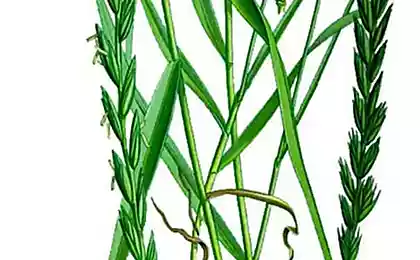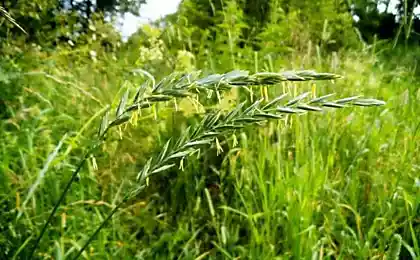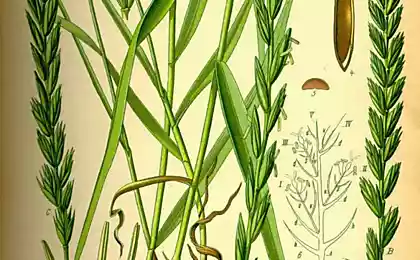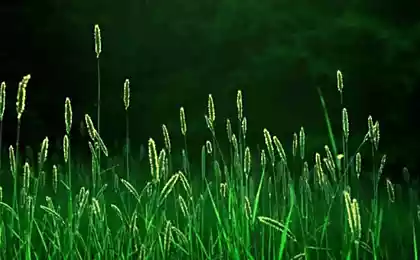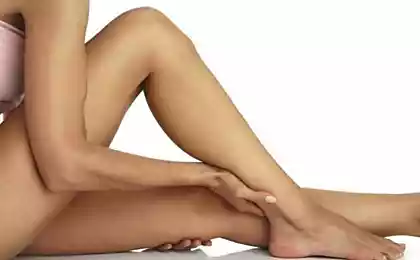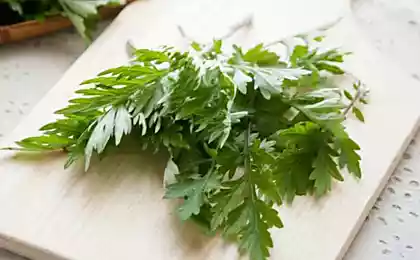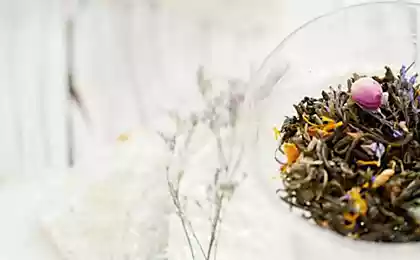221
Properties of Crawling Wheat for Health
Crawler (Agropyrum repens) is one of the most common weeds and a headache for many gardeners: not only does it deplete the soil, but it is almost impossible to get rid of it.

Ruthlessly removing wheatgrass from the site, many gardeners do not realize that kilograms of ripped grass can fundamentally improve their health.

DepositPhotos
After all, cats and dogs do not for nothing like to chew these long hard leaves - animals intuitively feel their natural power, which is simply a sin not to use people to maintain and restore their health.
Feeder creeping Hood breeds seeds and division of roots. This is a very tenacious plant, the substances contained in it allow seeds to germinate already at 2 degrees Celsius, while young shoots are not afraid of either drought or frost. For this, the people call wheatgrass “baby”, “dive”, “worm-grass”.
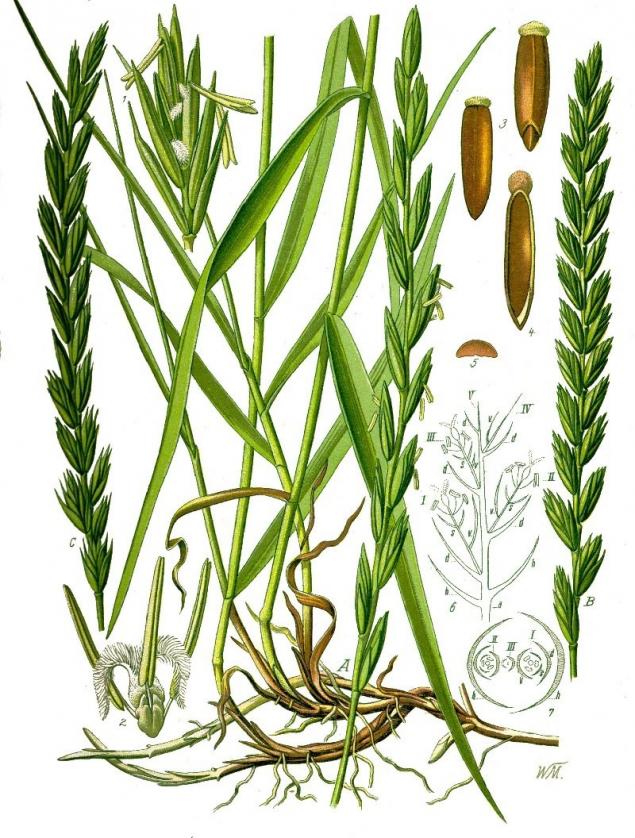
In difficult years, our ancestors used tenacious weed for food purposes. Famous herbalist, 90-year-old Elena Zaitseva says: “When people plowed gardens in early spring, we collected weed roots all over the village, mostly wheatgrass.

DepositPhotos
In our attic 30 bags of roots were stored. We'll wash them, we'll dry them. Mother baked bread from this flour - it is tastier and more nutritious than wheat. There was a terrible famine in the war, but we survived thanks to weed roots.
My mother said that God gives people the grass they need. If you have a plot of land, see which weed you grow the most – this will be your cure.
Weed wheat contains a long list of valuable substances: carotene, ascorbic acid, malic acid, proteins, carbohydrates, essential oil and, very valuablely, silicon, which contributes to the retention of calcium in the body.
 18
18
Indications for the use of creeping wheat Properties of a creeping wheatgrass make it a valuable medicine for patients with various articular, skin, colds.
They also allow you to use the breadbasket for the prevention of one of the most common diseases of our century - osteoporosis (its symptoms are manifested in 80% of women after the age of 50 years).
What cures wheatgrass
Use in folk medicine For therapeutic purposes grass-root They are harvested in spring or autumn. Clean from small roots, thoroughly washed and dried in air, then crushed. But, unlike other roots, wheatgrass can be harvested and consumed all summer.
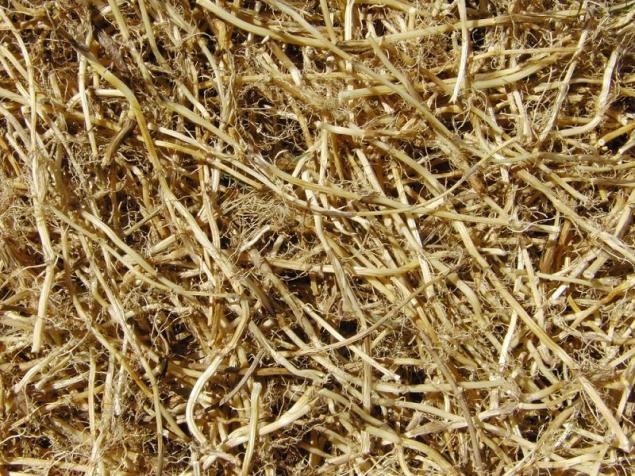
Before drying, thoroughly clean the rhizomes and wash in cold water. Drying raw materials is recommended at 60 degrees in the oven or special dryers, periodically stirring and turning. Ready rhizomes should break with a crack, without deforming. The storage period is not more than 3 years.
Medications
It is not recommended to use wheatgrass for the treatment of children under 2 years of age and pregnant women, since there is no accurate information about the effect of wheatgrass on the body of the child and the fetus.
Remember that the keys to health are literally underfoot, once you notice them and apply them.
There are herbs for the stomach that improve digestion, for which you do not need to run to the pharmacy. They're right next to you in your kitchen. And these are herbs that we used to use only as spices!
Flowers, leaves and stems of plants are the healthiest alternative to tea leaves, and more diverse. Try replacing regular tea and coffee with herbal drinks.

Ruthlessly removing wheatgrass from the site, many gardeners do not realize that kilograms of ripped grass can fundamentally improve their health.

DepositPhotos
After all, cats and dogs do not for nothing like to chew these long hard leaves - animals intuitively feel their natural power, which is simply a sin not to use people to maintain and restore their health.
Feeder creeping Hood breeds seeds and division of roots. This is a very tenacious plant, the substances contained in it allow seeds to germinate already at 2 degrees Celsius, while young shoots are not afraid of either drought or frost. For this, the people call wheatgrass “baby”, “dive”, “worm-grass”.

In difficult years, our ancestors used tenacious weed for food purposes. Famous herbalist, 90-year-old Elena Zaitseva says: “When people plowed gardens in early spring, we collected weed roots all over the village, mostly wheatgrass.

DepositPhotos
In our attic 30 bags of roots were stored. We'll wash them, we'll dry them. Mother baked bread from this flour - it is tastier and more nutritious than wheat. There was a terrible famine in the war, but we survived thanks to weed roots.
My mother said that God gives people the grass they need. If you have a plot of land, see which weed you grow the most – this will be your cure.
Weed wheat contains a long list of valuable substances: carotene, ascorbic acid, malic acid, proteins, carbohydrates, essential oil and, very valuablely, silicon, which contributes to the retention of calcium in the body.
 18
18Indications for the use of creeping wheat Properties of a creeping wheatgrass make it a valuable medicine for patients with various articular, skin, colds.
They also allow you to use the breadbasket for the prevention of one of the most common diseases of our century - osteoporosis (its symptoms are manifested in 80% of women after the age of 50 years).
What cures wheatgrass
- Skin diseases
The main therapeutic property of wheatgrass is its ability to “clean” the blood and the body as a whole from toxins, toxins and other “polluting” substances. The use of decoctions and tinctures of the plant allows you to get rid of skin diseases from the inside. - Upper respiratory diseases
Anti-inflammatory and expectorant properties of wheatgrass allow you to use it for the treatment of colds, bronchitis, tracheitis, pneumonia. - Liver diseases
Dust perfectly cleanses the blood, so it is useful for hepatitis, diseases of the biliary tract and alleviates the patient's condition with cirrhosis. - Diseases of the digestive tract
With gastritis, colitis, enteritis and stomach ulcers, a decoction of wheatpeas envelops the damaged mucosa, reduces inflammation and contributes to faster tissue regeneration. - Diseases of the cardiovascular system
With angina, arrhythmia and hypertension, the use of wheatgrass helps to reduce the amount of cholesterol in the blood and strengthen the walls of blood vessels. - Diseases of the bone-articular system
With rheumatism, gout and arthritis, the regular use of decoctions and tinctures of wheatgrass helps reduce inflammation in the joints and facilitates the movement of the patient. - Anemia, vitamin deficiency, chronic fatigue
Stress, insomnia, increased irritability and unreasonable anxiety are all indications for the use of wheatgrass. The high content of vitamins, minerals and silicon makes wheatgrass an indispensable tool for the treatment of nervous diseases.
Use in folk medicine For therapeutic purposes grass-root They are harvested in spring or autumn. Clean from small roots, thoroughly washed and dried in air, then crushed. But, unlike other roots, wheatgrass can be harvested and consumed all summer.

Before drying, thoroughly clean the rhizomes and wash in cold water. Drying raw materials is recommended at 60 degrees in the oven or special dryers, periodically stirring and turning. Ready rhizomes should break with a crack, without deforming. The storage period is not more than 3 years.
Medications
- Skin diseases.
A decoction of wheatgrass is taken half a glass 3 times a day for 1 month. To prepare the broth boil half a liter of water, let it cool and pour 4 tablespoons of crushed dry wheatgrass roots. Leave the broth for 10-14 days and strain. Do not throw out the roots after filtration, but use it again - pour 1 cup of boiling water, insist for 1 hour, strain and connect with the first decoction. - In diseases of the stomach and intestines
A decoction of wheatgrass is taken half a glass 4 times a day, 30 minutes before meals, 10–14 days. To prepare a decoction, grind 5 tablespoons of dry roots, pour a glass of warm boiled water and leave for 10 days, then strain, and the remaining roots pour a glass of boiling water and leave for an hour, mix 2 decoctions and use for treatment. - For articular diseases
Pour 30 grams of crushed wheatgrass roots with two glasses of boiling water and leave for 12 hours. Take a quarter glass 3 times a day 1 month. - Like a diuretic.
A decoction of rhizomes of the creeping wheatgrass is used as a diuretic, expectorant, "blood cleansing" and regulating salt metabolism. For cooking, take 1 part of the roots and ten parts of water, boil until half of the liquid remains, take 1 tablespoon 3-4 times a day. - To restore vision
Mix fresh grass juice wheatgrass with honey in a ratio of 1: 1, cook, stirring, on a low heat for 5 minutes. Take a tablespoon 3 times a day from spring to autumn daily. - To relieve fatigue.
Wheat tea is an excellent tool to combat fatigue and overstrain, and its high content of silicic acid makes it useful for lung diseases, gout and rheumatism. To prepare tea, two teaspoons of crushed root pour a glass of cold water, bring to a boil and immediately strain. Wash your eyes with chilled tea when they are tired of working long hours at the computer. - To prevent osteoporosis
Herbalist Lydia Surina recommends a bundle of wheatgrass to boil for 10 minutes in a pot of water, the grass after throwing away, and cook soups and porridge on a broth. This will enrich the body with useful substances, including silicon, which prevents the removal of calcium from the body and helps strengthen bones, which is especially important for the elderly.
It is not recommended to use wheatgrass for the treatment of children under 2 years of age and pregnant women, since there is no accurate information about the effect of wheatgrass on the body of the child and the fetus.
Remember that the keys to health are literally underfoot, once you notice them and apply them.
There are herbs for the stomach that improve digestion, for which you do not need to run to the pharmacy. They're right next to you in your kitchen. And these are herbs that we used to use only as spices!
Flowers, leaves and stems of plants are the healthiest alternative to tea leaves, and more diverse. Try replacing regular tea and coffee with herbal drinks.
